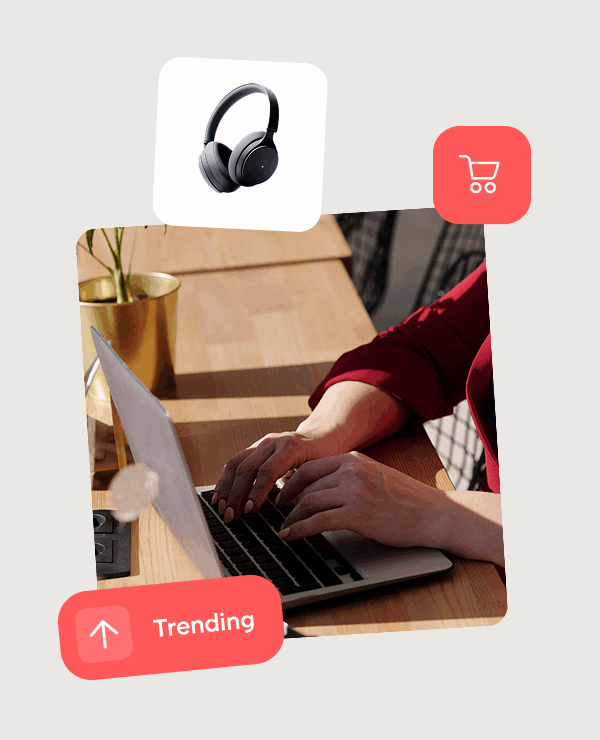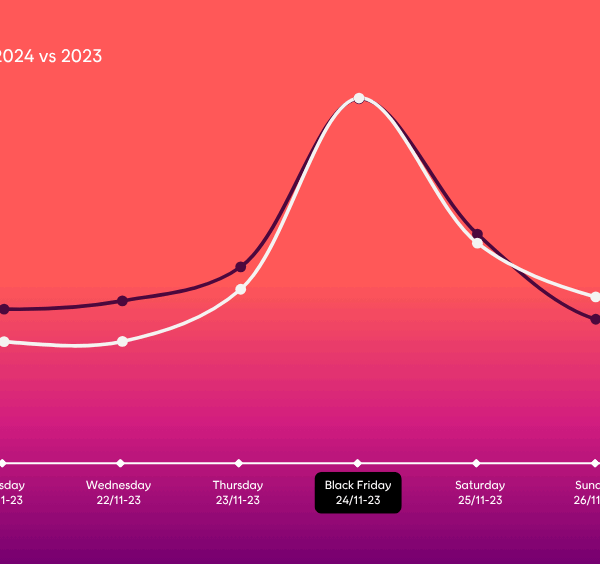TL;DR
Short on time? Here are the key takeaways:
- Gen Z shopping habits mix online and offline shopping, but digital is always the starting point.
- Social media and social commerce drive discovery, especially for beauty products and fashion.
- Gen Z consumers are savvy shoppers. They value sustainability, ethical practices, and personal values.
- Mobile phones, mobile payments, and social media platforms shape their shopping journey.
- To earn Gen Z’s loyalty, retailers must align with their values, personalize the purchase process, and deliver seamless online and in-store experiences.
Generation Z is shaping the future of retail.
Gen Z isn’t just another consumer group. They are true digital natives with values and shopping habits that are rewriting the rules of retail.
Nearly half of Gen Zers say they’ve put themselves on a shopping ban in the past year. At the same time, their spending power already rivals older generations .
For retailers, this mix of influence and unpredictability is impossible to ignore. Get it right, and Gen Z shoppers become loyal advocates. Get it wrong, and they move on fast.
Time to get to know them.
Who is Generation Z?
Generation Z, also called Gen Z or zoomers, includes people born from the mid-1990s to the early 2010s. This slips them between the Millennials and Gen Alpha.
Gen Z shoppers are true digital natives. They grew up with mobile phones, social media platforms, and instant access to products online.
This makes them savvy shoppers who research products online before making online purchases or heading in-store.
At the same time, their outlook is shaped by challenges like student debt and financial pressure.
Compared to previous generations, they are more cautious but also more willing to let their personal values guide purchasing decisions. Ethical practices, sustainability, and authenticity matter just as much as price.
Changing the face of retail
Gen Z shopping habits reveal a generation that blends online and offline shopping without hesitation. They start by scrolling social media, research products online, and then decide whether to buy online or in-store.
Nearly 90% of Gen Z consumers say social platforms influence their purchasing decisions.
This behavior is reshaping the retail landscape in three key ways:
- Values drive sales – Gen Z expects brands to be transparent about supply chains, sustainability, and ethical practices.
- Category focus – Female Gen Z consumers spend heavily on fashion and beauty products, while younger Gen Z often leans into impulse buying.
- Broader influence – Gen Z’s loyalty (or lack of it) doesn’t stop with them. It spills over to households, shaping purchasing decisions for other generations.
Gen Z isn’t just changing how people shop. They’re also changing how much gets spent and where.
Let’s look at their spending habits and growing spending power next.
Spending habits and spending power
Gen Z spending power is already reshaping retail. In the Nordics, Gen Z shoppers increased their spending by nearly 24% year over year. That growth is outpacing older generations like Gen X and Baby Boomers.
Gen Z’s spending habits reveal a few clear trends:
- Savvy shoppers – Gen Zers research products online, compare prices, and look for promotions before making online purchases or shopping in-store.
- Digital-first payments – Mobile apps and Apple Pay are second nature. Convenience is non-negotiable.
- Mix of restraint and impulse – Nearly half of Gen Z respondents put themselves on shopping bans, yet impulse buying remains common, especially for beauty products and fashion.
- Values matter – Many younger Gen Z buyers expect brands to reflect their personal values. Sustainability and ethical practices often guide purchasing decisions.
This mix of discipline and impulse shows why retailers can’t treat Gen Z like previous generations.
Their expectations are different, and their influence on the retail landscape is only growing.
Next, let’s look at what Gen Z expects from brand loyalty and customer experience.
Brand loyalty and customer experience
Gen Z’s loyalty has to be earned. They don’t stay loyal to brands out of habit like older generations.
Instead, they expect brands to deliver real value and meaningful connections. In the Nordics, 73% of total retail revenue now comes from customers who engage with loyalty and retention communications.
What Gen Z looks for in loyalty and experience:
- Personalized rewards – Offers must reflect real behavior and values, not just generic discounts.
- Seamless omnichannel – They move easily between online shopping and in-store experiences, so the journey has to feel connected.
- Social commerce – Almost 90% of Gen Z in the Netherlands say social platforms influence their purchases. Retailers need to meet them on TikTok, Instagram, and other platforms where shopping starts.
- Proof, not promises – Ratings, reviews, and word of mouth carry more weight than brand slogans. Björn Borg used ratings and reviews to boost engagement.
- Frictionless payment – From Apple Pay to mobile apps, checkout must be fast and easy.
Winning Gen Z’s loyalty is about relevance, transparency, and convenience.
Next, let’s follow their complete shopping journey, from discovery to purchase and beyond.
The Gen Z shopping journey
For Gen Z shoppers, the path to purchase is not linear. It moves quickly across digital and physical touchpoints:
1. Discovery
A new product appears in their feed through TikTok Shop, Instagram, or word of mouth on social media platforms. Curiosity is sparked.
2. Research
They head online to dig deeper. Gen Zers check reviews, compare prices, and look at how other consumers shop. They might browse an online store or head to a store to see the product in person.
3. Decision
Once satisfied, they are ready to buy. Mobile apps, mobile payments, and simple checkout flows keep the process smooth, whether it is online shopping or brick-and-mortar shopping.
4. Purchase
The transaction itself is quick. Apple Pay, one-click checkout, or in-store scanning make the process frictionless.
5. Post-purchase
The journey does not end with the sale. Gen Z expects follow-up: digital receipts, loyalty points, personalized offers, or even a nudge to leave a review. This step decides whether they stay engaged or move on to other brands.
Gen Z’s journey is fluid, fast, and connected. Retailers that meet them at every step, online and offline, are the ones who win repeat business.
How retailers can win Gen Z
You know what Gen Z values. Now it is time to act. Here are practical ways to meet their expectations, with real examples to show what works.
- Personalize every interactionUse customer data to tailor offers, messages, and rewards. Gen Z expects relevance, not generic discounts.Example: JACK & JONES built a member club that personalizes experiences across online and in-store. Members now spend 33% more per order compared to non-members.
- Blend online and offline shoppingGen Z moves between channels without thinking about it. Connect digital and physical touchpoints so their journey feels seamless.Example: LAKRIDS BY BÜLOW unified customer data across e-commerce and stores, making it easy to identify loyalty members wherever they shop.
- Leverage social proofReviews, ratings, and user content carry more weight than brand claims. Make it easy for Gen Z to see and share real experiences.Example: Björn Borg integrated ratings and reviews, boosting engagement and collecting insights to improve their products.
- Offer flexible paymentsGen Z expects speed and convenience at checkout. Support mobile payments, one-click checkout, and Buy Now Pay Later options.Example: Retailers across Germany report that failing to offer flexible payments can directly stop Gen Z shoppers from completing a purchase.
- Build loyalty through communityGen Z wants to feel part of something bigger than a transaction. Create membership programs or exclusive experiences that reflect their values.Example: NELLY transformed customer experiences by focusing on personalization and engagement that goes beyond discounts.
Winning Gen Z is not about gimmicks. It is about relevance, trust, and connection, delivered at every step of the shopping journey.
Why acting now matters for Gen Z and beyond
Gen Z is not just another generation of shoppers. They are digital natives with spending power, personal values, and shopping habits that are reshaping the retail landscape.
From researching products online to expecting seamless in-store experiences, their journey is fast, flexible, and driven by trust.
For retailers, the opportunity is clear. The businesses that adapt now with personalization, community-driven loyalty, and seamless online and offline shopping will be the ones that win Gen Z’s loyalty for years to come.
Ready to see how Voyado can help you connect with Gen Z and future-proof your retail strategy? Book a demo today.
FAQs
What defines Generation Z shopping behavior?
Generation Z shopping behavior is shaped by being true digital natives. Gen Z shoppers research products online, use mobile apps for payments, and expect brands to align with their personal values.
What are the key Gen Z shopping habits retailers should know?
Gen Z shopping habits include mixing online and offline shopping, relying heavily on social media for discovery, and expecting seamless experiences across mobile phones, online stores, and in-store browsing.
How does Gen Z’s spending power compare to other generations?
Gen Z spending power is growing faster than Gen X and Baby Boomers. Gen Z buyers are already influencing household purchasing decisions and driving trends across the retail landscape.










